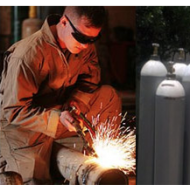INDUSTRIEL OXYGEN

| Multi-Industry Uses for Oxygen: Oxygen is used with fuel gases in gas welding, gas cutting, oxygen scarfing, flame cleaning, flame hardening, and flame straightening. In gas cutting, the oxygen must be of high quality to ensure a high cutting speed and a clean cut. Metals Manufacturing Uses for Oxygen: The largest user of oxygen is the steel industry. Modern steelmaking relies heavily on the use of oxygen to enrich air and increase combustion temperatures in blast furnaces and open hearth furnaces as well as to replace coke with other combustible materials. During the steel making process, unwanted carbon combines with oxygen to form carbon oxides, which leave as gases. Oxygen is fed into the steel bath through a special lance. Oxygen is used to allow greater use of scrap metal in electric arc furnaces. Large quantities of oxygen are also used to make other metals, such as copper, lead, and zinc. Oxygen enrichment of combustion air, or oxygen injection through lances, is used to an increasing extent in cupola furnaces, open-hearth furnaces, smelters for glass and mineral wool, and lime and cement kilns, to enhance their capacity and reduce energy requirements. Smelting times and energy consumption can also be reduced by special oxy-oil or oxy-gas burners in electro-steel furnaces and induction smelters for aluminum. A high thermal efficiency is achieved by these “oxy-fuel” burners, which mix fuel and oxygen at the tip of the burner. As a result, rapid combustion occurs at approximately 2800o C (5072oF). Chemicals, Pharmaceuticals and Petroleum Uses: Oxygen is used as a raw material in many oxidation processes, including the manufacture of ethylene oxide,propylene oxide, synthesis gas using partial oxidation of a wide range of hydrocarbons, ethylene dichloride, hydrogen peroxide, nitric acid, vinyl chloride and phthalic acid. Very large quantities of oxygen are used in coal gasification — to generate a synthesis gas that can be used as a chemical feedstock or precursor for more easily- transported and easily-used fuels. In refineries, oxygen is used to enrich the air feed to catalytic cracking regenerators, which increases capacity of the units. It is used in sulfur recovery units to achieve similar benefits. Oxygen is also used to regenerate catalysts. Oxygen is used to achieve more complete combustion and destruction of hazardous and waste materials in incinerators. Glass and Ceramics Industry Uses: Conversion of combustion systems from air-fuel to oxy-fuel (and construction of new furnaces and tanks around this technology) results in better control of heating patterns, higher furnace efficiencies (lower fuel consumption) and reduction in particulate and NOx emissions. Pulp and Paper Manufacturing Uses: Oxygen is increasingly important as a bleaching chemical. In the manufacture of high-quality bleached pulp, the lignin in the pulp must be removed in a bleaching process. Chlorine has been used for this purpose but new processes using oxygen reduce water pollution. Oxygen plus caustic soda can replace hypochlorite and chlorine dioxide in the bleaching process, resulting in lower costs. In a chemical pulp mill, oxygen added to the combustion air increases the production capacity of the soda recovery boiler and the lime-reburning kiln. The use of oxygen in black liquor oxidation reduces the discharge of sulfur pollutants into the atmosphere. |


